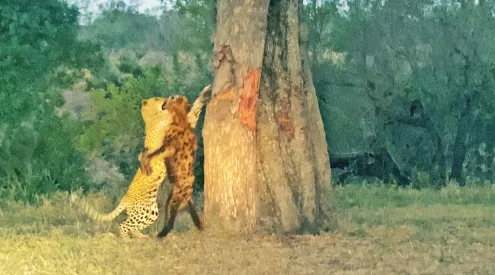Ole Naeku was every bit the proud Maasai warrior – tall and lean, intricate beadwork offsetting his traditional red shuka. Just the kind of young buck I could picture killing a lion with his bare hands as part of the ceremony to become a full-blown maroni (warrior), practised in the past when lions were more plentiful than Maasai. There was a dagger in his belt; in one hand he carried a spear and from the fold of his robes he plucked a Samsung Galaxy S10. I was clearly in good hands.
Ole was to be my guide for a first-ever day trip into the Masai Mara, Kenya’s oldest reserve and the world’s original benchmark for the African safari. Its popularity has somewhat detracted from the ‘wildness’ of the Maasai homeland, but these fertile green plains dotted with flat-topped acacia are still the killing fields where toothy critters eat their herbivorous compatriots for dinner daily. And it’s where, every spring, thousands of wildebeests run the gambit of crocodiles to cross the Mara River.
The game-drive vehicle had a ‘sunroof’ which was a perfect photographic perch for me as we idled slowly through herds of zebra and snorting wildebeest. ‘Just tap when you want to stop,’ instructed Ole from behind the wheel. ‘And say, “OK, let’s go,” when you want to move on.’
We came to a carcass being stripped by lappet-faced and white-headed vultures. I tapped. We stopped. Hook-beaked birds were swooping in, squabbling and rushing at opportunistic jackals. It made for excellent photography, but eventually it was time to move on.
‘Ok, let’s go.’
No reaction. I said it a bit louder. No reaction. I tried tapping on the roof and raising my voice a few decibels. No reaction, so I popped my head back down into the cab. Ole was sprawled out, head lolling over the back of the seat, eyes closed. Motionless. Dead, I thought, panic seizing me. I was the only passenger; there were no other vehicles around.
Suddenly my basic first-aid training kicked in: ABC – check airway, breathing, circulation. It was about at the point where my ear was at his mouth to test for breath and my fingers were exploring his neck for the carotid artery, that Ole snapped awake and in one motion started the vehicle and we were off. What he thought about the middle-aged mzungu woman feeling him up, he never did say.
And so it went. Ole and I fell in to a perfect rhythm. We stopped at giraffes, four cheetah brothers under a tree, ellies with babies, and my first ever topi. I’d take pics, Ole would catch 40 winks. Then I’d tap his slumbering form firmly and say, ‘OK, let’s go.’ And off we’d go to the next sighting.
We came to two lions sleeping under a bush. The cloud of flies tormenting them suggested they were dead and in the first stages of decomposition. But the occasional flick of a tail spoke otherwise. Vehicles came, watched for a while and left again.
On hot days lions sleep, and watching them is, I admit, an almost unendurably soporific endeavour. I began to feel just like Ole but, like a gambler wanting just one more roll of the dice, I waited, finger on the camera trigger, for just one more minute, then another and another.
Suddenly the silence was split by a thunderous, snorting snore from Ole. Going from sleep to full attack mode in less than a second the lions leapt to their feet. Tails flicking, menacing counter rumbles coming from their throats. There was a ‘whirrrrrr’ of camera motor drives from other vehicles. I got the shot I’d been waiting for.
There were no more snores, and by and by the lions settled down again. ‘Ok, let’s go,’ I said tapping him awake.
‘Yes,’ agreed Ole. ‘They won’t move now. They sleeping until this evening.’
So, we drove to the shade of an acacia, Ole spread a checked Maasai cloth on the ground and we had a lovely picnic. Then I lay back and dozed off peacefully in one of the greatest game parks in Africa with my brave Maasai protector snoring softly by my side.


















